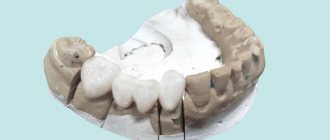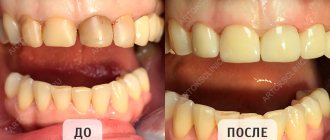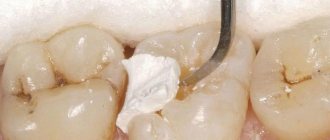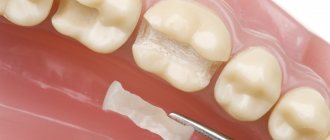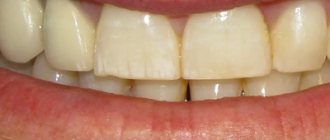After the patient has gathered his will into a fist, visited the dentist and had his teeth treated, he begins to worry about the question of how long the filling will last? How long can you enjoy a beautiful smile and not think about doctors and pain?
There is an opinion that service life depends on cost, however, this is not entirely true. If you remember how much free metal fillings installed back in Soviet times cost, you understand that it’s not about money. For the most part, the lifespan of a crown or inlay depends on two factors:
- The material from which the structure is made.
- Doctor's skill and quality of work.
Is a refilling necessary if nothing bothers me?
Many patients are surprised when a dentist recommends replacing an old filling with a new one, because they have no pain or other unpleasant symptoms. However, replacement is carried out not only in cases of severe inflammation, but also for preventive purposes, as well as to improve the aesthetics of the dentition.
Like any other material, the filling mass is subject to gradual wear, deformation, and destruction. Hygienic care, oral microorganisms, saliva pH, mechanical, chemical and temperature effects of food over time provoke the appearance of microscopic cracks in the filling. The resulting pores serve as a breeding ground for microbes and the development of dental diseases.
What is a light filling and when does it become necessary to place it on a tooth?
What is a light filling and why do dentists recommend placing it on a tooth when treating caries? Light (photopolymer, light-curing) filling is what ordinary people far from medicine call a filling material that hardens only under the influence of ultraviolet radiation. The hardening process of light fillings occurs quickly - in just 40-60 seconds and to start it, the dentist will use a special UV lamp.
THIS IS INTERESTING: The speed of hardening of light fillings is one of their advantages. They harden under the influence of ultraviolet light in less than a minute and acquire high strength. Chemical filling composites take about 2 hours to harden.
Light fillings can be placed on teeth both for the restoration of chewing units and for high-quality restoration of teeth included in the smile zone. This type of filling material is highly durable, aesthetically pleasing, and has a wide range of shades, which allows you to select and place a light filling exactly to match the natural enamel of the patient’s teeth.
Indications for the use of light fillings are as follows:
— Treatment of caries, pulpitis, periodontitis of teeth.
During the treatment process, the dentist will drill out the tooth and remove all tissue destroyed by caries. As a result, a cavity is formed that needs to be closed both to prevent bacteria from entering the internal tissues of the tooth and to return the tooth to all its functions and attractive appearance; — You can also put a light filling on a tooth if the enamel is chipped, if part of the tooth breaks off due to a minor injury;
— In some cases, aesthetic restoration of teeth is carried out using light fillings. For example, if the tooth enamel has become very dark and cannot be whitened using professional whitening techniques.
But you should know that the decision to put a light filling on a tooth will not always be the right one - if your tooth is destroyed by more than 50%, it is better to restore it with an inlay or a crown. Light fillings have high strength, but with such tooth destruction they may not withstand constant and heavy load.
How long can a filling last?
The service life of a filling is determined by several factors, the main ones being the following:
- correct installation and size,
- characteristics of the material from which it is made,
- the condition of the abutment tooth, the thickness of its walls,
- features of hygienic care: brush hardness, abrasiveness of pastes, etc.
- the presence or absence of certain habits: for example, high consumption of nuts, seeds, opening corks with teeth,
- the predominance of solid and/or tough foods in the diet, and so on.
As a rule, the minimum service life is 3-5 years, but some materials can last 10 years or more. In fact, it depends more on the condition of the treated tooth itself after a while.
Varieties
Such composites contain:
- silicates – almost 45% consist of silicon, which gives the mass transparency and shine after it has completely hardened. It has a high coefficient of mechanical stability and good strength.
The main difference from other cements is the complete absence of the zinc element in them, which results in its disadvantage - low adhesion to enamel tissues.The process of complete crystallization is about 28 days, which is much slower than analog mixtures. It includes silicic acid, which releases toxins, so when installing such a filling, a gasket is required that does not allow direct contact of silicates with the pulp;
- phosphates – modified zinc-based cements. In terms of their basic physical and chemical characteristics, they are somewhat better than silicates.
At the same time, they are very inferior to them in terms of aesthetics, so they are practically not used for frontal filling. The consistency is more viscous.Such compositions are an ideal option for subsequent covering with decorative crowns. They finally harden just a few hours after the manipulation.
In demand in pediatric dentistry. For complete hardening, it is advisable to exclude direct contact of the composite with saliva;
- glass ionomers – belong to the modern and widely used cements by Russian doctors. They represent an almost ideal ratio of liquid and powder.
It is characterized by good transparency and resistance to the acidic environment contained in saliva, which increases the durability of the material.It does not irritate the natural tissues of the organ and adheres well to them. The material is safe for the pulp. Gives low shrinkage during operation.
Almost all of them, with the exception of the last material, are chemically active components and harden naturally.
Glass ionomer hardens only when interacting with an acidic environment or light wave flows.
Why does caries develop under the filling mass?
The development of a carious process under the filling material is often observed due to poor-quality treatment of the tooth cavity during treatment. The remains of the affected tissues serve as a source of infection, which intensifies and covers increasingly larger areas of the dentition unit.
Caries can also form if the filling is carried out in violation of the protocol. An incorrectly applied composition quickly becomes unusable, losing its fixation with the walls of the tooth cavity or collapsing under the influence of the aggressive environment of the oral cavity. Microbes penetrate into the resulting cracks and voids, which “trigger” the destructive process.
Another factor that provokes the development of caries is the natural “aging” of the filling. The appearance of microdamages (and micropores) on it and in it, which is inevitable over time, contributes to the accumulation of pathogenic bacteria, their reproduction, and the occurrence of recurrent disease. Therefore, it is advisable to replace old fillings with new ones after their expiration date.
Preparatory activities
Preliminary manipulations before installing a cement filling:
- a thorough inspection of the working surface for the presence of inflammatory formations, removal of plaque and rocky deposits so that their fragments do not fall into the tooth cavity and internal initiation does not occur;
- X-ray diagnostics - this is the only way to understand the true clinical picture and extent of the lesion;
- anesthesia and dissection of the damaged organ;
- preparation of the working area - it is expanded to the required size, given the necessary relief, sharp fragments and irregularities are ground off. All these measures will be the key to strong fixation of the mass;
- separation of the organ from neighboring units with a cotton swab or paper sponges - thus eliminating contact with salivary secretions, which negatively affects the quality and time of hardening of the cement mass;
- local-spectrum medications
- drying the treated part of the tooth with targeted air flows;
- if necessary, apply insulating material. To do this, using a cotton pad, dentin obtained by mixing distilled water and dentin powder in a ratio of 1:2 is evenly distributed along the bottom of the cavity. Then the remaining composition is removed with a special spatula;
If there is no need for a gasket, it is enough to simply treat the inner surface after its preparation with a special conditioner for 10 - 15 seconds. Then rinse well with water and dry thoroughly with air.
The main thing is to prevent the surface from becoming too dry, otherwise the adhesion strength of the cement to the inner surface of the hole will be worse.
What does aching teeth mean and the causes of the unpleasant phenomenon.
In this publication, we suggest that you familiarize yourself with the international classification of caries according to ICD 10.
Follow the link https://www.vash-dentist.ru/lechenie/zubyi/effektiven-li-analgin-ot-boli.html if you are interested in whether Analgin helps with toothache.
What types of fillings are there?
Today, various materials are used to fill teeth. The most widespread are the following:
- cement: it is cheap, therefore it is actively used in the budget dental field. Fillings made from this material are susceptible to destruction, short-lived (maximum - 1-2 years), when replacing them, doctors often diagnose a carious process,
- amalgam: based on mercury, copper and silver. They are characterized by high strength, but the appearance leaves much to be desired. In addition, mercury is a toxic substance,
- <>photopolymers: the most modern option. They harden in the light, are durable, highly aesthetic and natural in appearance. On average, they last about five years,
- chemically cured composites: the material cures on its own, without exposure to a blue light lamp (but can still be used to speed up the process). A very durable composition, most often applied to chewing areas - premolars and molars. Aesthetics worse than photopolymers,
- glass ionomer cements: differ from classical cements in a large number of advantages, because They last a long time, the price is not too high, they are low allergenic and can be installed for children.
Filling teeth without pain
Nowadays people do not need to be afraid of visiting the dentist, because dental treatment is carried out without pain. High-quality anesthesia is used, and an allergy test is performed first. If the body accepts the drug normally, then the dose is administered in the gum area. After 1-2 minutes the effect appears. A person may notice that the problem area has lost sensation. After this, the doctor can proceed to the procedure itself.
When using anesthesia, a person will not feel pain. You will be able to relax in the dental chair and not worry about anything. This treatment option is the most preferable, because not every patient wants to endure pain.
Some people decide not to use anesthesia. This is because they do not want to administer the medicine or are suffering from an allergic reaction. If the nerve is not affected, the procedure will cause virtually no pain. An experienced specialist will do everything to make the patient feel as comfortable as possible.
When is a refilling required?
To determine when a filling needs to be replaced, you should contact your dentist. He will conduct a diagnosis, including x-rays, and, if necessary, carry out a replacement.
Indications for refilling are the following conditions:
- pain in a filled tooth,
- crown destruction,
- detection of caries under filling material,
- feeling of an unpleasant taste,
- decreased aesthetics of the restoration,
- expiration of the seal's service life.
The most common situations in which refilling is required are discussed below.
Changing Hue
Yellowness, darkening and other color changes in the filling (and enamel) most often indicate the presence of a destructive process in the tooth. If there is a reddish tint, it means that the previously installed material contains resorcinol - in this case, not only a refilling is required, but also additional cleaning of the canals, as well as an internal bleaching procedure.
Abrasion of the filling mass
Over time, the fillings wear out, which leads to disruption of the distribution of chewing load. As a result, the bite changes, the load on the temporomandibular joint increases, TMJ pathologies develop, and digestive problems arise.
Overhanging filling
If installed incorrectly, the filling material may “hang” over the adjacent tooth or gum. The accumulation of food particles and impaired contact between units of the dentition provoke an inflammatory process in soft tissues, the proliferation of microorganisms and the development of caries, and bleeding gums.
Subsidence of the filling mass
Shrinkage is typical for any materials used for filling. If it occurs along the axis of the tooth, a person’s bite may change, which will lead to problems with the TMJ and digestion. In addition, vertical subsidence provokes the appearance of cracks and even chips in the tooth, since, as the filling contracts, it “pulls” the hard tissues along with it. When subsidence occurs in the horizontal plane, the degree of contact between adjacent units changes, food debris gets stuck in the interdental spaces, the formation of caries and gum inflammation are observed.
Flat filling surface
If, when filling, the dentist did not pay due attention to the chewing surface, but made it flat, disruption of the chewing process will gradually lead to the development of problems with the gastrointestinal tract. Normally, there are cusps and fissures on it, which ensures full contact with the opposite teeth of the other jaw.
Roughness has appeared
The rough surface of the filling indicates the presence of pores and microscopic cracks in it. This means that microbes have already penetrated into it. Often, when the filling material is removed in such cases, caries is revealed underneath it.
Expired service life
Even if the filling was installed more than 10-15 years ago and still holds, it does not mean that it is fulfilling its function. In the vast majority of cases, when refilling such “rarities”, an extensive carious process is determined.
Unaesthetic appearance
Refilling may be required if the previously installed filling stands out in shade from the background of the remaining teeth. Most often, the situation occurs after the whitening procedure. Over the period of operation, old compounds have absorbed various coloring substances, so to restore the aesthetic appearance (especially of the front units), they need to be replaced.
General overview
Cement composite used in dentistry is made from a powder mixture and a liquid concentrated acid composition.
As a result of the combination of these elements, a mass is formed, characterized by a paste-like consistency, capable of hardening in a fairly short time.
Advantages of the material:
- lower cost of the composite compared to alternative solutions;
- when working with cement, the use of complex devices and tools is not required;
- the procedure for forming the mass and its installation is carried out quickly and does not require special training of the dentist.
Cement fillings are not without their disadvantages:
- the hardened composite is unable to maintain its original shape and volume over a long period of time;
- the time required for the mass to completely harden is an order of magnitude longer than that of many modern filling compounds;
- poor resistance to external negative mechanical influence - unable to withstand the pressure exerted on them, the composition cracks and gradually loses its structural integrity;
- does not guarantee recurrent manifestations in the form of the development of repeated caries;
- in the process of incorrectly installing a filling, there is a risk of puncturing a part of a healthy organ;
- cement belongs to the category of toxic elements, and is not always biocompatible with natural tissues.
Drugs used for intraligamentary anesthesia and manipulation techniques.
Read reviews about dental treatment under a microscope here.
At this address https://www.vash-dentist.ru/lechenie/zubyi/kofferdam-v-stomatologii.html the price of a rubber dam in dentistry is announced.
How does the replacement take place?
Many patients are worried: is it painful to change a filling? The procedure is performed under local anesthesia and is therefore absolutely painless.
In general terms, re-sealing occurs as follows:
- anesthesia is administered
- the desired tooth is isolated from the oral cavity with a rubber dam: so that moisture and microorganisms do not enter the treated cavity,
- old filling material and tissues affected by caries (if any) are removed
- the cavity is treated with a special etching solution and dried,
- an insulating or medicinal pad is applied,
- a new filling is applied.
Restoration takes place with mandatory consideration of the anatomical features of the chewing surface.
How much should you not eat after filling a tooth?
Filling is considered a simple procedure, after which a person immediately returns to his normal lifestyle. At the same time, dentists warn that it is undesirable to eat and drink drinks right away. It is advisable to abstain from food for 2-3 hours. During this time, the filling will take root, so the food will not be harmful in the future.
It is recommended not to drink coffee or strong tea for 24 hours to avoid staining the material. If the procedure is carried out well, the person will not encounter any problems, and will therefore be able to fully chew with the repaired tooth.
How to extend the service life of filling material
How often the filling will have to be changed depends on how correctly it is used. To extend the life of the material, just listen to the following tips:
- don’t skimp on material: very cheap means it won’t last long,
- avoid increased stress on the filling: do not open bottles, avoid excessively hard foods,
- avoid sudden changes in temperature in the oral cavity: do not take too hot or cold food,
- select oral hygiene items and products in accordance with the characteristics of the teeth.
In addition, even in the absence of complaints, you need to regularly visit the dentist for timely detection of pathologies and defects. It is better to spend a few minutes grinding than to have to refill it after some time. Preventative visits will save time and money, and will also keep your nerves and teeth in perfect order.
Reviews
Despite the relatively short service life of dental fillings with this type of composite, its popularity is steadily growing.
Their installation on masticatory organs is especially preferable. And the process of dismantling the remains of the composition if it becomes unusable is not associated with tooth trauma and discomfort.
If you are interested in this treatment option for affected units, you can leave your comment or review of the material in a special section.
If you find an error, please select a piece of text and press Ctrl+Enter.
Tags treatment fillings cement fillings
Did you like the article? stay tuned
Previous article
Depophoresis in dentistry - what is it and how is it used?
Next article
How to recognize taurodontism, and how dangerous the pathology is

